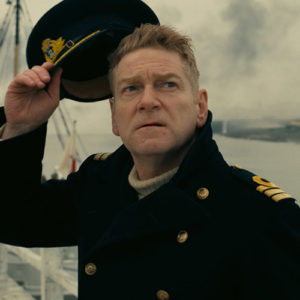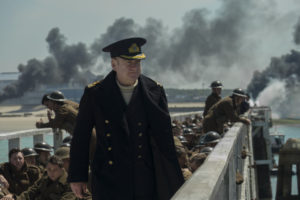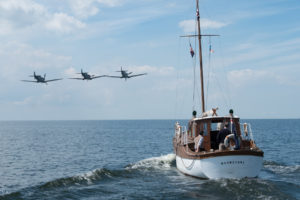 Christopher Nolan’s Dunkirk, which explores the origins of WWII, takes place mostly on beaches, boats and in the air. Nolan’s long-time colleague, the Oscar nominated Production Designer, Nathan Crowley was tapped to recreate this dark time in history. Crowley’s first collaboration with Nolan was on the crime thriller, Insomnia and his body of work includes Prestige, The Dark Knight and Interstellar.
Christopher Nolan’s Dunkirk, which explores the origins of WWII, takes place mostly on beaches, boats and in the air. Nolan’s long-time colleague, the Oscar nominated Production Designer, Nathan Crowley was tapped to recreate this dark time in history. Crowley’s first collaboration with Nolan was on the crime thriller, Insomnia and his body of work includes Prestige, The Dark Knight and Interstellar.
Crowley began his career as a set designer on Hook, Maverick and the cult favorite, Escape From L.A. He has also served as Art Director on such high profile films as Braveheart and Mission Impossible: II. A passionate student of David Lean’s films, Crowley had always wanted to work on an epic film of this scale. “It was very much an English story,” said Crowley. “I think Chris wanted to tell it as a huge dramatic piece, and that became very attractive. He’s always got an interesting approach. I had to do it.”
Along with trusted colleague Crowley, the behind-the-scenes creative team included director of photography Hoyte van Hoytema, editor Lee Smith, costume designer Jeffrey Kurland, visual effects supervisor Andrew Jackson and special effects supervisor Scott Fisher. One of filmmakers’ many logistical challenges would be to create an authentic narrow pier extending over a mile out to sea where Allied troops would be bombed. One of the most distinctive features on Dunkirk was widely known as “the mole.” Rebuilding this set piece was integral to the filmmaking as the mole played a vital role in the evacuation, because the beach itself is extremely shallow, making it impossible for big ships to get to the shore. The soldiers crowded onto this narrow breakwater is an amazing visual. Thousands pushed their way onto this little sliver that juts out into the ocean and stood there, completely vulnerable to aerial assault.
 The production’s restored mole was also vulnerable to attack, but from nature. In order to enable their mole to withstand the force of the ocean, Crowley’s art department had it constructed with 14×14-inch timbers for its legs, using a crane barge to slowly build it out to sea. “There was about 600 feet of existing pier construction, and then we had to add about 500 feet,” said the production designer. “It was a major undertaking that required the help of the city, the port authority, the port engineers, and dredging companies. And because we try to do things in camera, that also meant getting ships to agree to moor on a set structure. It was very tough to film practically.” The shoot was also fraught with challenges because it was hit by some truly terrible weather at the time. One storm was so bad that it caused the waves to tear strips from the production-built mole.
The production’s restored mole was also vulnerable to attack, but from nature. In order to enable their mole to withstand the force of the ocean, Crowley’s art department had it constructed with 14×14-inch timbers for its legs, using a crane barge to slowly build it out to sea. “There was about 600 feet of existing pier construction, and then we had to add about 500 feet,” said the production designer. “It was a major undertaking that required the help of the city, the port authority, the port engineers, and dredging companies. And because we try to do things in camera, that also meant getting ships to agree to moor on a set structure. It was very tough to film practically.” The shoot was also fraught with challenges because it was hit by some truly terrible weather at the time. One storm was so bad that it caused the waves to tear strips from the production-built mole.
Crowley affirmed, “The only plus was that every time the water peeled boards off the mole, it would always deposit them on the same bit of beach. So we knew where all our parts were, and could go and get them and put them back on. It was a constant repair job.” Apart from the mole, Crowley’s team also had to recreate an entirely different type of water access. “One thing the soldiers did at the time was build these makeshift piers out of 10 trucks—driving them out into the water and lining them up,” Crowley illustrated. “So we ended up building a truck pier, too…and learned the difficulty of building a truck pier,” he deadpanned. Weather wasn’t the only thing that hampered filming on the shoreline. The tide was almost as much of an obstacle for the production as it had been for the evacuating army back in 1940.

Some of the ships acquired for the film were repurposed in inventive ways. The minesweepers, for example, were dressed by Crowley’s team to look like destroyers in background shots. Crowley remarked, “We also got an old Coast Guard ship from Rotterdam, which was about 200 feet long, to which we added scaled-down guns and towers and clad the exterior to give it a destroyer profile.” However, not everything could be achieved on the waters of the English Channel or Ijsselmeer. They also built gimbals on Stage 16 at Warner Bros., which has one of the largest water tanks in the world. It was used it for interiors of ships that required some effects with hulls swaying and buckling. Crowley also related that they filmed “some exteriors at Falls Lake at Universal Studios, where we shot the sinking of a 120,000-pound ship.”
 One crucial step was obtaining the planes. Nathan Crowley secured three Spitfires—two Mark 1s and one Mark 5—as well as a Spanish HA-1112 Buchón to double for the German ME-109s, better known as Messerschmitts. The cockpit scenes especially called for experienced filmmaking and expertise as one wonders where the crew could possibly mount the camera.
One crucial step was obtaining the planes. Nathan Crowley secured three Spitfires—two Mark 1s and one Mark 5—as well as a Spanish HA-1112 Buchón to double for the German ME-109s, better known as Messerschmitts. The cockpit scenes especially called for experienced filmmaking and expertise as one wonders where the crew could possibly mount the camera.
Both Crowley and Nolan had been raised with the mythological tale of the Dunkirk invasion. It was personally imperative to the crew to deliver the raw intensity of the fight on land, sea and air. Their collaborative efforts to work through challenging problems proved successful, as the film is a true testament to unity.
Learn more http://www.warnerbros2017.com/videos/?film=dunkirk





